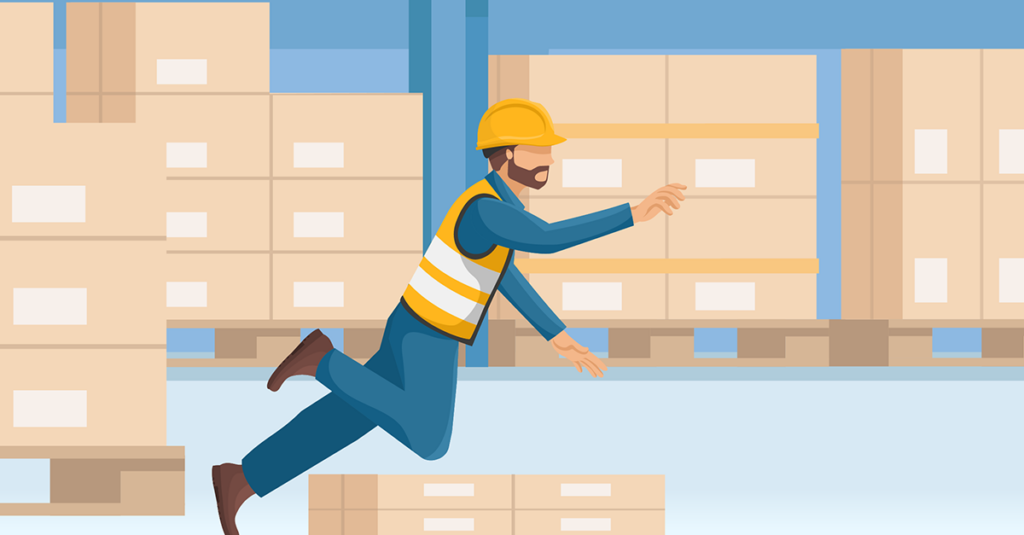Why Slips, Trips and Falls Continue to Cause Serious Workplace Incidents
May 1, 2023

Slips, trips and falls, or falls that happen on the same level, can be some of the most debilitating and expensive injuries workers will suffer and contribute to 700 worker fatalities each year. It is particularly hazardous in the construction industry, accounting for 378 of the 986 construction fatalities recorded in 2021. To address this concern, the National Safety Stand-Down to Prevent Falls in Construction is held each year to encourage employers to stand down from work and discuss workplace hazards relating to trips, falls or other job safety concerns.
In this three-part series dedicated to walking-working surfaces, Scott Gaddis—Vice President, Global Practice Leader, Safety and Health at Intelex Technologies, ULC—provides his expert insight into the risks associated with pedestrian safety in the workplace and what employers need to do to mitigate them. Part I below looks at common types of slips, trips and falls and how they occur. Part II discusses how risk assessment can help prevent slips and trips in the first place. Part III examines how the hierarchy of controls can contribute to continuous safety improvement in fall prevention.
Pedestrian Safety in the Workplace
Pedestrian safety is not an issue to be overlooked. The Bureau of Labor Statistics says that on average, slips, trips and falls cause nearly 700 fatalities per year. OSHA reports that as many as 30,000 forklift accidents occur in the United States annually and close to 20 percent of those accidents involve a pedestrian being struck by the forklift. Of these forklift events, 35 percent resulted in death to the pedestrian.
Falls from heights and on the same level (a working surface) are among the leading causes of serious work-related injuries and deaths. OSHA estimates that, on average, approximately 202,066 serious (lost-workday) injuries and 345 fatalities occur annually among workers directly affected by OSHA’s final rule to update, align and provide greater flexibility in its general industry Walking-Working Surfaces and Fall Protection standards. Over 60 percent of all falls occur on the same level, the result of slips and trips.
Preventing pedestrian accidents in the workplace has long been challenging. Working alongside a wide range of material handling equipment, traveling across ill-prepared work surfaces and dealing with elements like weather, congestion and poor illumination is, in many cases, part of work for many.
Adding to this are distractions like cell phones, and we have a perfect storm of substandard conditions met by an increase of undesired behaviors.
Protecting Workers From Slips, Trips and Falls
In 2017, OSHA published changes to the standards related to walking-working surfaces and personal fall protection systems to better protect workers in general industry from these types of hazards and the dangers posed to the pedestrian worker. The final rule has updated and clarified standards and added worker training and equipment inspections as required steps in risk mitigation.
While I believe the updated changes focus on falls from heights, falls to the same level and to the working surface itself are part of the control expectations. The regulatory language used in the final rule is “performance-based,” meaning there’s more room for employers to select the equipment and controls that will be most effective in the workplace. Simply put, it requires the employer’s knowledge to perform to the rule’s intent.
Pedestrian safety and how the worker navigates his or her walking-working environment requires a complete understanding of risks, the level of risk posed to the worker and the controls warranted that provide better safety.
How Slips, Trips and Falls Occur
Both slips and trips result from an unintended or unexpected change in the contact between the feet and the ground. Slipping occurs when the friction between the foot or shoe sole and the floor surface provides insufficient resistance to counteract the forward or rearward forces that occur during the stepping process. According to an ergonomic study performed by T. Leamon, there are two types of slips: a “micro slip” that is shorter than 1.18 inches (3 cm) and a “slip” that is as long as 3.14 -3.9 inches (8–10 cm). Sliding also should be considered, and it is regarded as the uncontrolled movement of the heel when the slip length exceeds approximately 3.9 inches (10 cm).
Microslips generally pass unnoticed. A slip will result in instinctive efforts to regain postural control. A slide is likely to lead to a loss of balance resulting in a fall. A trip occurs when the swing phase of the foot is interrupted unexpectedly due to inadequately clearing the ground. Irregularities of as little as 3/16 inch (5 mm) in the walking surface may be sufficient to cause a trip. These all are critical considerations when planning fall prevention at your worksite.
Inspecting for Slips, Trips and Falls Hazards
Fall prevention strategies should be comprehensive and multifaceted but should begin with a complete understanding of the variable risk factors that create a loss potential opportunity. Given that there have been changes to OSHA’s walking-working surfaces standard, it’s prudent to consider risk assessment as a starting point to understand the robustness of your program and if you should be doing more.
Consider what risks in your workplace may lead to slips and trips. Here are a few areas that should be evaluated:
Slippery Surfaces
It’s a safe assumption that most injuries occur on a slippery floor. Assessment should be conducted to understand if the floor surface is impacted by liquid or dry spillage. Some areas to consider are surfaces impacted by production materials like wet and dry sifted ingredients, dust, oils and greases; equipment required to run with water or other fluids; food service; and around sinks and areas outside affected by the weather like ice and snow. Drains where liquids may accumulate and where down spouts disperse rainwater also should be assessed.
Changes in Surface Elevation
As previously mentioned, it takes very little elevation change to impact safety for the pedestrian worker. Assessment should be conducted to understand damaged or uneven flooring, the heaving of the floor surface or wide cracks commonly found in concrete flooring, uneven door thresholds, ramps, floor mats and thick carpets, to name a few.
Surface Illumination
The appropriate level of light in the work environment is challenging. Assessments should be done with a full understanding of what tasks are being done and the detail of those tasks. Poor illumination offers dimly lit walk-work surfaces, promoting injury risk, but too much light increases glare, which also promotes risk to the worker. The Illuminating Engineering Society (IES) has published appropriate light levels and has recommended lux levels for different industrial applications. In general, lux levels for warehouses and walkways should be 100, general work areas 150, general assembly 300, detailed assembly 500 and fine inspection 1000. Lighting requirements should be considered with ample research since there is not one solution for everyone considering the wide array of tasks. Every facility is different.
Shared Surface Inclusion
Mixing pedestrian workers and motorized or non-motorized equipment is dangerous. Where these areas are present in your operation, risk assessment should be performed to understand where work tasks are performed in or near areas where motorized and non-motorized equipment may enter the walking-working surface. Assessment areas should consider barriers, designated walk paths, exclusion zones, clothing and required equipment interaction areas.
Blind Corners
Creating a safe work environment between groups of workers and workers who are interacting with material handling or motorized equipment is a real and present danger. Assessment should be conducted where people could inadvertently run into each other and where workers could be struck by an object like a forklift or falling object. Particular attention should be focused on corners, where there is poor visibility of the walking environment.
Obstruction and Obstacles
Carrying materials that obstruct the view of the walking-working surface increases the chance of falling. Assessment should be performed by watching workers and how they are carrying out these types of duties. Also, obstacles like electric cords, parts left outside of storage locations, tools and equipment and air hoses also should be assessed.
Worker Urgency
It’s just a fact that workers usually have a purpose for pedestrian travel, and things like fast-paced work, missing co-workers or attending to an operational upset increase the potential for slips and falls. Assess the pace of the work and the behaviors of workers to gauge if they are working above their level of competence in their ability to maintain safety.
While your inspection can be conducted manually with our Walking-Working Inspection Checklist, Intelex also provides Safety Inspection software, which allows you to quickly and easily schedule inspections, review checklists, capture evidence and respond to incidents in the field via mobile, both online and offline. It’s a more efficient and accurate method of conducting inspections that will help you achieve compliance and mitigate risks.
After your inspection process has concluded, it’s time to gain traction in your walking-working surfaces program. In Part II of this series, we’ll look at how risk assessments can help you understand how to prevent pedestrian incidents before they happen. In Part III, we’ll look at how using the Hierarchy of Controls can help manage the risk of falls in the workplace.
Ready to improve workplace safety? Watch our demo to see how Intelex Safety Inspections Software helps you streamline inspections, identify hazards and protect your workforce.






